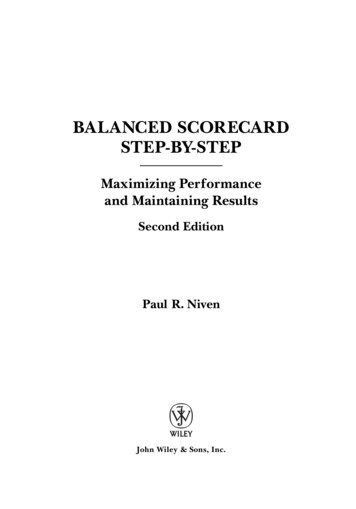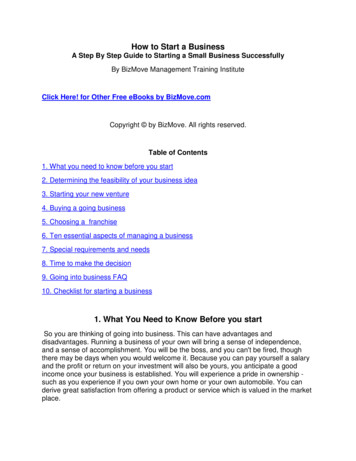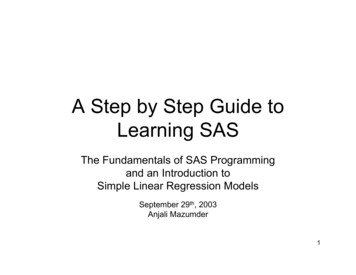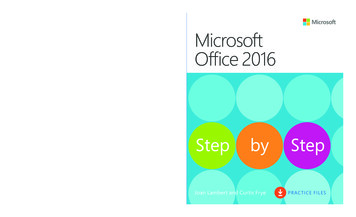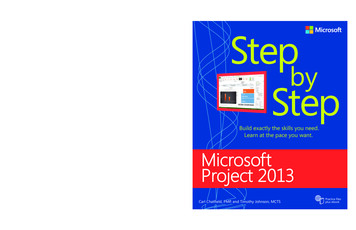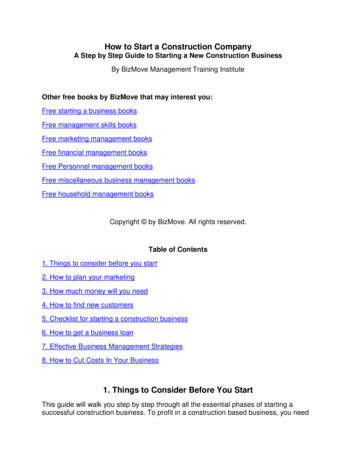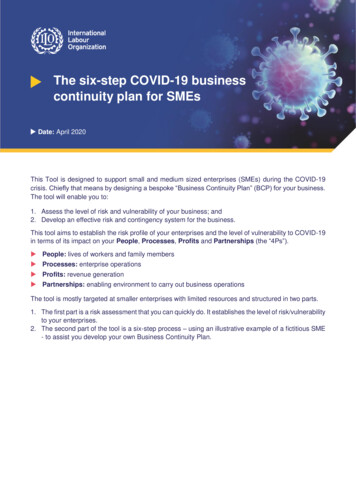
Transcription
The six-step COVID-19 business continuity plan1The six-step COVID-19 businesscontinuity plan for SMEs Date: April 2020This Tool is designed to support small and medium sized enterprises (SMEs) during the COVID-19crisis. Chiefly that means by designing a bespoke “Business Continuity Plan” (BCP) for your business.The tool will enable you to:1. Assess the level of risk and vulnerability of your business; and2. Develop an effective risk and contingency system for the business.This tool aims to establish the risk profile of your enterprises and the level of vulnerability to COVID-19in terms of its impact on your People, Processes, Profits and Partnerships (the “4Ps”). People: lives of workers and family members Processes: enterprise operations Profits: revenue generation Partnerships: enabling environment to carry out business operationsThe tool is mostly targeted at smaller enterprises with limited resources and structured in two parts.1. The first part is a risk assessment that you can quickly do. It establishes the level of risk/vulnerabilityto your enterprises.2. The second part of the tool is a six-step process – using an illustrative example of a fictitious SME- to assist you develop your own Business Continuity Plan.
2The six-step COVID-19 business continuity planPart 1: Establish your risk profile - Self-assessmentIndicate your answers to the yes/no questions below with an X. There are four sections composed ofa total of 60 questions structured around the “4Ps” ‘People, Processes, Profits and Partnerships’. Youcan estimate your vulnerability level by adding up the number of times your answer was “yes” in eachquestionnaire.Answer YES if you are not sure or don’t know.I. People: Risk MatrixSafe working environment1. There are current personal safety risks such as a high number of COVID-19cases in the geographical area of your operations.YesNo2. It is physically unsafe for workers to come and go from the workplace (e.g.using shared public transport etc).YesNo3. There has been an increase in sick leave/absenteeism.YesNo4. Due to the nature of my business, it is not possible to re-arrange work soworkers can work from home (telework).YesNo5. You are experiencing difficulties sourcing sufficient sanitation facilities(washing facilities, sanitizers, hand gels, gloves, masks etc).YesNo6. Vehicles used for your business (e.g. delivery, staff movement) have not yetbeen fitted with sanitizers and processes for regular cleaning.YesNo7. Workers have increased care/family responsibilities due to school closure orsick family members.YesNo8. There have been cases of internal transmission of COVID-19 by staffmembers or their immediate family members.YesNo9. Workers are less motivated due to a stressful working environment resultingfrom measures taken to address COVID-19.YesNo10. Workers are leaving their jobs because of potential or actual safety concernsand/or incidents.YesNo11. Discriminatory/stigmatization behaviour among workers have led to threatsand intimidation of fellow workers.YesNo12. Close physical contact with customers/suppliers is necessary.YesNo
The six-step COVID-19 business continuity plan13. Workers have experienced personal trauma such as death or sickness offamily members as a result of COVID-19.YesNo14. Close proximity in the workplace is necessary for production/service deliverypurposesYesNo15. There is no staff member responsible for daily review of official advice on risksand recommendations in relations to COVID-19.YesNo16. There are no or few procedures to conduct self-inspections to identify hazardsthat could result in COVID-19 spreading (e.g. regular health and safety checkups conducted).YesNo17. There are no or few regular audits in your premises to identify current oremerging hazards (e.g., areas requiring frequent physical touch).YesNo18. Workers are currently not provided with direct training (or access to training)on COVID-19 preparedness and basic measures to protect themselves andothers.YesNo19. My business does not have a process for reporting to public health authoritiesany known or suspected instances of workers or the public confirmed withCOVID-19 on the business premises.YesNoTotal / 19II. Processes: Risk MatrixBuildings and machinery20. You have faced difficulties accessing the necessary equipment and machineryto run your business from suppliers.YesNo21. There has been disruption or significant delays to support services that youneed for maintenance of key equipment and machinery.YesNo22. Your business (e.g. workers, equipment and livestock) is neither partly norfully insured.YesNo23. A high percentage of your raw materials are imported.YesNo24. You have experienced delays in securing raw materials/ necessary productioninputs through ports.YesNoStock and raw materials3
4The six-step COVID-19 business continuity plan25. You have experienced difficulties in securing your key stock and rawmaterials.YesNo26. Your enterprise has been negatively impacted by increased governmentrestrictions/demands (for example increased Health checks delaying deliveryof products coming/going from your premise).YesNo27. Your main stocks and/or raw materials are located in only one location.YesNoTotal / 8III. Profits: Risk MatrixMarkets28. COVID-19 disruptions are negatively impacting your clients and their ability tobuy your products or services.YesNo29. Official government measures relating to health concerns for the overallpopulation are negatively affecting your business sales.YesNo30. You have a high percentage of goods/services that serve non-domesticmarkets.YesNo31. These markets are located in medium to high-risk countries.YesNo32. There has been a decrease in sales to these markets.YesNo33. Disruptions are negatively impacting on your main suppliers and their ability tosupply inputs to your enterprise.YesNo34. You have experienced disruptions in your supplies due to increasedgovernment restrictions.YesNo35. You have only one supply route to access your key suppliers.YesNo36. You do not have alternative suppliers that could provide goods and services incase of disruption.YesNo37. You rely heavily on foreign suppliers for most of the key inputs and rawmaterials needed for your business (over 75 per cent of key inputs)YesNoSuppliers
The six-step COVID-19 business continuity planSociety38. There has been a rise in "societal" intolerance and prejudice as evidenced inthe media, street demonstrations and political discourse, among others.YesNo39. The current media environment has negatively influenced the workingenvironment.YesNo40. COVID-19 is impacting on economic activity that directly impacts yourbusiness or the markets you operate in or you expect it to.YesNo41. Unemployment rates are rising in the markets you operate in.YesNo42. There has been an increase in actual criminal activity or increased risk ofcriminal activity directed at your enterprise as a result of depressed economicactivity.YesNo43. There has been a sudden increase in the price of inputs and other goodsrequired to conduct your business operations.YesNoEconomic environmentTotal / 16IV. Partnerships: Risk MatrixPublic utilities (water, electricity, health, sanitation)44. There has been significant or ongoing disruptions of key public utilities (water,electricity, telecoms, health and sanitation) that has negatively impacted yourbusiness or the markets you operate in.YesNo45. There has been significant or ongoing disruptions of key public utilities (water,electricity, telecoms, health and sanitation) that has negatively impacted yourworkers (i.e. sanitation facilities at home).YesNo46. There has been negative or sudden change of the costs related to publicutilities.YesNo47. There has been an increase in corruptive practices for access to public utilitiesor public infrastructure (such as health care).YesNoThird parties (costumers, competitors and financial providers)5
6The six-step COVID-19 business continuity plan48. COVID-19 disruptions are negatively impacting your competitors and theirability to remain competitive.YesNo49. There is limited or no scope to collaborate with competitors – to share healthand safety practices/equipment.YesNo50. There is limited or no scope to collaborate with competitors –to share stock.YesNo51. There is limited or no scope to collaborate with competitors –to shareequipment.YesNo52. It is more difficult to access finance or the behaviour of financial servicesproviders (e.g. increased lending obligations, less choice of providers, etc.) isnegatively impacting your enterprise operations.YesNo53. Restrictions to accessing public infrastructure have been put in place thatnegatively impacts your enterprise or the markets you operate in or yourworkers.YesNo54. There is increased costs of using key public infrastructure that negativelyimpacts your enterprise or the markets you operate in.YesNo55. There has been any negative or sudden change of regulations (i.e. laws andregulations) that negatively impacts your enterprise or the markets youoperate in.YesNo56. There is an increased uncertainty in policy/regulatory environment that couldnegatively impact your enterprise or the markets you operate in.YesNo57. Has there been any negative or sudden change of regulations (i.e. laws andregulations) that negatively impacts on your workers?YesNo58. The government has not yet introduced subsidies (e.g. rent or wage subsidies)that could help my business and workers during the COVID-19 outbreak.YesNo59. Measures such as “State of Emergency’ or major restrictions on freedom ofmovement have been put in place or threatened to be put in place?YesNo60. My business does not have a contingency plan for situations of crises.YesNoPublic infrastructure (telecommunications, roads, ports)Political and regulatory environmentOverall healthTotal / 17
The six-step COVID-19 business continuity plan7From this exercise, you will have identified which of the 4P’s (people, processes, profits andpartnerships) your enterprise is most vulnerable too (and which aspects or variables in particular). Tocalculate your total vulnerability, add up the times you answered “yes” in the four vulnerability selfassessments. Insert this sum in the cell below.Risk scorePeopleProcesses/ 19Profits/8Partnerships/ 16Total score/ 17/ 60Interpretation of your score: your risk profileThis score does not rate whether your enterprise is good or bad. It is simply a benchmark of yourenterprise and its vulnerability to COVID-19 that helps in the identification of areas where yourenterprises’ overall resilience to the COVID-19 crisis could improve. Most importantly it will tell youwhere you are most at risk – your workers, your supply chains, your reliance on third parties.Below is overall view of your score. If you score yes to:40-60Your enterprise is highly vulnerable to the negative impacts of the COVID-19 crisis. Yourenterprise is quite likely to be severely impacted, which may cause long-term disruption inthe event of a deterioration of the situation. Your next plan of action should be to identifywhether you are most vulnerable to internal or external threats and take measures toreduce risk and vulnerability to COVID-19.20-40Despite having taken some action to increase preparedness, your enterprise remainsvulnerable. Understand whether your threats are internal or external and make sure toprioritize your elements of vulnerability when establishing your business continuity plan.0-20You are on the right path towards becoming more resilient, but there are still some areaswhere you could reduce your vulnerability. Make sure to establish your business continuityplan in a way to manage risk of your internal and external threats.
8The six-step COVID-19 business continuity planPart 2: Develop a six-step COVID-19 Business Continuity PlanThe following are the six steps needed to establish your business continuity plan (BCP):Step 1: Identify your key products or servicesWhat are your most important products or services? Consider the following criteria: Share of income they generate; Amount of clients demanding them; and Cost of non-delivery: negative financial, productivity and reputational consequences.Step 2: Establish the objective of your BCPWhat do you want to achieve by establishing your BCP?Step 3: Evaluate the potential impact of disruptions to your enterprise and workersHow long can interruptions last before becoming unacceptable? What are the resources required andthe suppliers, partners and contractors needed to conduct key operations?Step 4: List action to protect your businessUse the 4Ps framework to do this. Actions to minimize risk to your: People, Processes, Profits andPartnerships (the “4Ps”). People: lives of workers and family members Processes: enterprise operations Profits: revenue generation Partnerships: enabling environment to carry out business operationsStep 5: Establish contact listsMore of your activity will be non-physical (WhatsApp calls, zoom meetings etc). Make sure you haveaccurate and update lists of all your key stakeholders.Step 6: Maintain, review and continuously update your BCPThe following is an example of how a small business owner put together a BCP for her business****
The six-step COVID-19 business continuity plan9How a small business owner developed a BCP to mitigate the impact ofCOVID-19Joyce Mkumura is the owner of company producing canned sardines in Mombasa on the Kenyan coast.She sells her products directly throughout Kenya and to larger firms who export. Joyce relies onconsistent orders from three companies for about 80 per cent of her business. These companies dueto their connections to the export market, send regular orders. As COVID-19 cases spread in KenyaJoyce developed a BCP to protect her business. She has a total of 30 workers.1Joyce completed the COVID-19 Risk Assessment test and realized her risk profile was high. She dealtwith multiple suppliers on a daily basis. Her workers worked in close proximity. She was reliant on theport staying open for much of her sales. The rest of her sales mostly went to other Kenyan cities andshe needed reliable transport links. Joyce realized she needed a BCP.Step 1: Joyce identified her key productsFor Joyce her main products are different types of canned sardines. Sales of these products are thesole means of revenue generated. Her client base is relatively small. She has three main customerswho constitute 80 per cent of sales. The cost of non-delivery to these customers would have a verynegative consequences on her business.Step 2: Joyce established the objective of her BCPThe goal was to develop simple internal processes for her business that would provide key protectionsfor the “4Ps”: people, processes, profits and partnerships. This meant: Maximize the physical and emotional safety of herself and her workers; Resume operations as quickly as possible following disruptions; Make sure that her key products are resilient to disruptions associated with COVID-19; Safeguard her supply chain; and Ensure that her enterprise fulfils its contractual commitments with clients.Step 3: She evaluated the potential impact of disruptions to her enterprise and workersShe assessed the impact of disruptions to her key operations. What operations are required to produceand deliver her products and what is her tolerated downtime: how long can key operations be out ofaction before it becomes highly damaging to the viability of the business. She identified what operationswere required to produce and deliver her products and where the risks where located? This involved ashort stakeholder mapping exercise. There are five main stakeholders that are critical to her business:Workers, customers, suppliers, support services and regulatory authorities. Workers: Joyce has thirty workers that are drawn from the local community (fortunately they mostlylive locally and walk to work). Customers: 80 per cent of her product is to three companies who export to foreign markets. Theremaining 20 per cent is for the Kenyan market (15 per cent to wholesalers based in Nairobi). Suppliers: She is dependent on three suppliers. First a metal (tin) producer; second a printingcompany based in Nairobi for the labels for her products; and third and most important local fishers1This is a composite example of a BCP based on the real experiences of enterprises in Kenya. Joyce Mkumura is however a fictional person.
10The six-step COVID-19 business continuity planwho are grouped in cooperatives. All suppliers require regular communication, but physical contactis most regular with the fishers. Support Services: These include a trucking company that she uses and a security company. Public utility and regulatory authorities: These include the regulatory Food Standards body thatissues licenses; the taxation authority and a local government departments that oversee healthand safety standards.This exercise showed Joyce how dependent her businesses is on external actors remaining healthyand in the case of her suppliers, support services and customers, able to stay in business. She quicklyrealized that she could potentially go bankrupt within four to six weeks if she was badly disrupted. Sheassessed “what would be the impact of not conducting her key operations?” She looked at each of thestakeholders above and realized that any disruption to them would mean a disruption to her business.She assessed her main potential disruptions as follows: Workers falling sick (hers/suppliers/support services); Government restrictions on freedom of movement could affect her (and her suppliers) ability to getto work; Government restrictions on accessing the port could affect her customers’ ability to get herproducts to market; Inability of government utilities to provide services (water and electricity were of chief concern);and Drop in demand for her products.She thought about the events that were outside her control and how they could impact her suppliersand what were within her control that she control to some extent. On the negative side, she was highlydependent on others, chiefly her suppliers and she has no influence over government restrictions thatmay come. On the positive, the demand for tinned/canned products was rising.Step 4: Joyce took actions to protect her operationsPeople She decided to limit the contacts points to a single one in her business and set up a sanitationpoint there so she and her workers were less exposed. Apart from safety/sanitation measures she reviewed the standard ways of working and adaptedsocial distance criteria. This would require new shift arrangements which she discussed with theworkers. She prepared for increased absenteeism.Processes While leading the overall initiative, she asked workers to volunteer for the following tasks: ensuringsanitation points were well stocked daily; establishing a temperature checking station at entrancefor all workers/suppliers/customers/visitors; daily consultation with suppliers and customers toassess their situation and any changes that have occurred; and making sure everybody wasfamiliar with ways to stay safe at home. She discussed with all customers and suppliers what their safety systems where and that theywere adhering to the new regulations.
The six-step COVID-19 business continuity plan11 She still paid some suppliers (fishers for example) in cash. She used this as an opportunity to moveall payments (ongoing or incoming) into a digital format. She backed up all of her data regularly or automatically and kept it additionally at home in caseshe had to self-isolate.Profits She noticed that demand for tinned/canned products was rising. There was an opportunity herefor increased sales. She negotiated an agreement with a local five-star hotel, for cold storage spacefor key inventory and secondary secure space for final products. Her final products had a longershelf life which was a real advantage. She discussed with her main suppliers the fishers Cooperative who told her they had agreementswith other cooperatives along the coast. If the Mombasa region was badly disrupted, alternativessources were available and agreements were in place to enable this. She worked out her daily operational costs (payroll, rent, supplies, etc.) and made simulationsbased on the financial needs if key disruptions occurred. She had regular conversations with the bank that had provided her with credit. The bank was awareof her “BCP plan” and was proving more flexible with loan requirements as a result, if these wereneeded.Partnerships She discussed with her three main (exporting) clients. She suggested that they ask the Federationof Kenyan Employers and other business associations to have discussions with the government toget some clarity that the port facilities can stay open. She struck an agreement with four other SME owners to share safety measures and practices foreach of their businesses. They agreed to a common set of procedures to keep workers safe. Theyalso agreed to share the cost of getting information on how to handle workplace issues like changesto working time, possible redundancies; and other HR issues. She discussed with the taxation authorities the possibility of tax deferrals which she had heardabout in the media.Step 5: Joyce established contact lists She listed key contact numbers of authorities and third parties (police, emergency services,firefighters, nearest hospitals, insurance company) that could provide help during emergencies. She made a list of her workers, their positions and contact details (mobile phone and email address)as well as worker’s emergency contact details. She made a list of her clients, suppliers, contractors and government agencies she worked with,including the contact person and details (mobile phone, email address and street address), all ofwhich allows her to communicate. She selected communication methods to connect with her workers during the COVID-19 crisis(Facebook, WhatsApp, Google forms) and established a staff emergency call tree.
12The six-step COVID-19 business continuity planStep 6: Joyce maintained, reviewed and continuously updated her BCPShe reviewed and updated her plan every week to: Update the objective of her BCP and to improve its effectiveness; Update her risk assessment, strategies for business continuity and other procedures contained inthe BCP; and Ensure continual improvement of all the processes included in her BCP. ContactILO Bureau for Employers' Activities (ACT/EMP)4, route des MorillonsGenève 22, Switzerland, CH-1211E: actemp@ilo.orgW: www.ilo.org/actemp
The six-step COVID-19 business continuity plan 1 This Tool is designed to support small and medium sized enterprises (SMEs) during the COVID-19 crisis. Chiefly that means by designing a bespoke “Business Continuity Plan” (BCP) for your business. The tool will enable you to: 1. Assess the level of risk an



